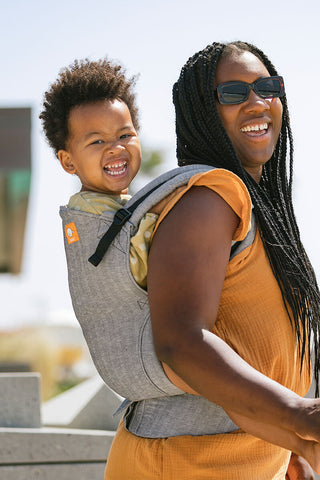Next to a front-carry, another great option to carry your child is in a back carry position. In many parts of the world, back carrying has always been a big part of parenting. It gave mothers the chance to work even though they had to take care of their child. Depending on the climate they lived in or the work that had to be done, they adapted their carrier material to their circumstances and surroundings.

Back carrying gives caretakers the chance to do all the daily tasks, while having their child close to them. It is a great bonding time for baby and caretaker. You can use all of our Tula Carriers for back carrying. Depending on how your child's height, one carrier should work better than others for you. Check out our different carrier styles.

Your child should be able to sit up on their own, before you start carrying them in a back carry. Our Tula carrier will support your child’s legs in their natural sitting position. Your benefit is that the weight in a back carry is easier to bear than in a front-carry.
Tips for a back-carry:
- before back carrying the child should be able to sit up on their own
- needs good head and neck control
- the child needs to be able to spread their legs across caregivers back
- smooth the carrier from the bottom to help your child have a good seat; don’t pull up on the straps
- practice first --> 1. sit on a soft surface when practicing, 2. have a spotter and 3. do it when your child is happy and well-rested
- if you are afraid of getting your child on your back by yourself, lay the carrier on the bed, position your baby in it, sit in front and buckle up
- practice until everyone involved gets comfortable with back carrying
- position the child in a deeper seat when back carrying
How to adjust the carrier for a back-carry?
- put carrier on and slightly adjust
- reach under your armpits and back to grab baby’s leg on one side
- reach up over your shoulder to grab the shoulder strap closer to the top of the body of the carrier
- lift and rotate
- pull up and forward on baby’s legs while gently bouncing and pulling up on the shoulder strap
- switch sides, repeat
- snug down the shoulder straps to get a more secure fit

Back carry will help to continue bonding time when your child gets bigger. The parents can still continue to do their important daily tasks, to run errands, take the dog for a walk, go to the farmers market and cook etc. Back carrying provides the parents with a little bit more flexibility and gives the child the chance to experience the interesting outside world from the comfort of their parents back.

